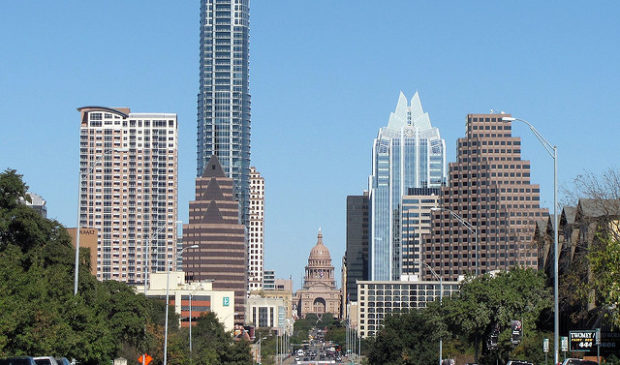As hotels and short-term rentals grow, a look at their impact on Austin
Friday, August 24, 2018 by
Chad Swiatecki With Austin on pace to have more than 13,000 hotel rooms in the downtown core by 2020 – nearly double the number of rooms in 2014 – the construction of new chain and boutique hotels continues to have an impact in local business and political spheres.
On the other side of the hospitality coin is the emergence of short-term rentals and companies that enable property owners to rent rooms or homes in residential neighborhoods or buildings, creating a still-new and shifting regulatory environment for the city.
The impact of the hotel and STR industries on each other and on the city as a whole was the topic of Wednesday’s monthly member breakfast for Urban Land Institute of Austin, with the panel discussion moving into the way major cities have grappled with STR emergence, how they impact Austin’s affordability crisis, and what impact the expansion of the Austin Convention Center is expected to have on the local hotel industry.
The discussion began with Tom Noonan, president and CEO of Visit Austin, reading data stating Austin attracted 27.4 million tourists in 2017, with $8 billion in economic activity as a result.
While STR usage has become more popular in Austin in recent years, especially during peak periods when hotel prices can approach $1,000 per night, the cumulative effect on hotel business has been about a 1 percent reduction in business, said Greg Clay, president of JMI Realty, which controls the Sheraton Austin and the Kimpton Hotel Van Zandt.
“In Austin, what it does is create a release valve for the consumer on high-occupancy time zones like (the Austin City Limits festival and Formula 1) when hotel rooms are $900 and 100 percent occupied so there is no availability. We’re still at that occupancy, but there’s 20,000 more people who come to Austin in short-term rentals,” he said.
“The impact to the industry has not been what we all thought it would be.”
Austin’s regulation of short-term rental business is still in a state of flux, since a 2016 ordinance that required a license for STR operators was challenged in court and state lawmakers have expressed a desire to make the practice widely accepted and minimally regulated.
T.J. Clark, co-founder and CEO of the TurnKey Vacation Rentals startup, said his company and others have taken the “ask for forgiveness, not permission” stance when it comes to negotiating local laws covering STRs. He said the business community, including real estate investors like Red McCombs, are quickly adopting STR-friendly policies into their developments, creating an expectation that owners will be able to generate extra income from their properties.
“In urban markets like Austin or Seattle or Miami, they’re still trying to figure it out,” he said. “They have a ton of corporate travel that’s never going to go away, and so this is an expansion of travel in our sharing economy that we’re living in. Now it’s time for urban markets to figure out a way to operate in a fair way for the single-family homeowners … because there’s demands on the developer side that are creating HOAs that are open for business when it comes to short-term rentals. The cities and counties have to do things properly and fairly.”
On the question of the impact of STRs on the price of Austin real estate, Clark and Branigan Mulcahy, head of real estate for Austin high-end apartment STR startup the Guild, said their business tends to be concentrated in higher-priced housing stock and likely doesn’t directly influence the availability of affordable housing.
Mulcahy added that the extra revenue the Guild generates for apartment buildings could potentially help builders subsidize the cost of adding more affordable units into a property, with the panel members speculating that Austin could one day build explicit STR allowances into development agreements in exchange for a higher percentage of affordable housing.
And with the proposed expansion of the Austin Convention Center taken out of the public conversation recently while it is being studied by classes at the University of Texas, Clay said the project that is anticipated to cost around $600 million would add more stable and predictable business to the Austin hotel market, with the added plus of generating more tax revenue from the city’s Hotel Occupancy Tax.
“Big citywide conventions help everybody, whether people want to admit that or not, because it’s creating a lot of additional tourism, creating occupancy tax and recognition of Austin,” he said. “Those groups ultimately will help the city because on the hotel side we rely on group demand and the corporate traveler to survive. So when the leisure market isn’t as strong as it is right now, we need to be attractive to the companies that are bringing big groups here.”
Photo by Michael made available by a Creative Commons license.
The Austin Monitor’s work is made possible by donations from the community. Though our reporting covers donors from time to time, we are careful to keep business and editorial efforts separate while maintaining transparency. A complete list of donors is available here, and our code of ethics is explained here.
You're a community leader
And we’re honored you look to us for serious, in-depth news. You know a strong community needs local and dedicated watchdog reporting. We’re here for you and that won’t change. Now will you take the powerful next step and support our nonprofit news organization?




